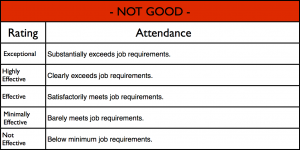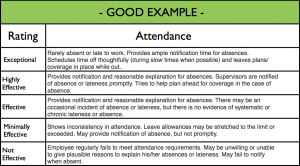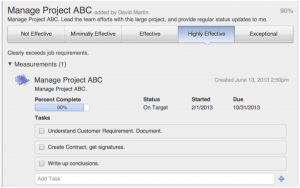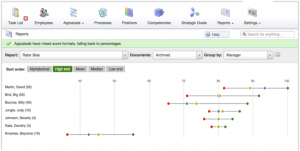3 Steps to Flatten Rater Bias
Posted by Julie • September 24, 2018 (Last modified June 8, 2022) • 4 min read
Rater bias is, by definition, an inaccurate distortion of a measurement. Everyone has biases, and we bring our biases to the table when appraising employee performance. Our biases can inflate or deflate an employee’s ratings, but we want to be fair.
How can an organization flatten Rater Bias? Here are three easy steps.
- Create awareness. Talk about the different kinds of rater bias with your managers and employees so they’ll be thoughtful of their own bias when reflecting on performance.
- Build in specific, measurable criteria into your Performance Appraisal forms.
- Measure the bias, then reflect again.
Step 1: CREATE AWARENESS
What are the different types of rater biases? Here are some common types.
- Central Tendency Bias: Maybe you’ve heard some managers say “I never rater anyone as “Excellent.” A central tendency bias is when a rater tends to rate everyone in the middle of a scale, perhaps a level 3 out of 5—the middle rating. The central tendency bias may happen regardless of individual differences in performance and is sometimes done to avoid conflict.
- Leniency Bias: Sometimes, a manager may rate more highly than other managers, or a manager may favor a particular employee. A leniency bias means that a manager may inflate ratings by being too lenient.
- Halo/Horn Effect: An overall positive or negative perception of an employee may create a halo or horn effect when rating. Think the employee is great at something? That positive emotion could lead to high ratings in other areas, by proximity. Frustrated with an employee? The negative association with a single event could spill over into lower overall ratings, whether or not those all areas are affected by the frustration point.
- Recency Bias: The recency effect is the tendency to allow recent events to dominate an evaluation, rather than considering performance over time. If an employee has had recent success, the rater may tend to rate all elements of the Appraisal highly. Something less successful happen recently? Ratings may be affected to the negative.
- Personal Bias: Get along well with an employee? Don’t connect? These personal biases can affect a rater’s bias.
- First Impression Bias: Remember the first time something terrific happened with an employee? What if the first thing that happened wasn’t as good? The First Impression Bias is when those impressions stick, regardless of subsequent successes or challenges.
- Spillover Effect: Past performance can affect current thinking. Has the employee been great in the past? Not so great historically? The spillover effect is when a rater carries past performance into a current Appraisal.
- False Attribution Bias: Has an employee had a great success lately? A failure? A rater may credit an individual with a particular success, or suggest the individual is at fault with the failure of something. Usually, success and failure are a combination of two things: individual effort, plus the strength of the system in which an individual works. Falsely attributing success or failure at the individual level without considering the supporting systems (those things which may be out of control of the individual) may over-inflate or unduly “ding” an employee when rating.
Step 2: BUILD A GOOD APPRAISAL FORM
All organizations want fair appraisals, so once you’ve talked about rater bias and created awareness, it is time to look at your actual Appraisal form to be certain it’s set up for success.
Make sure your appraisal form has competencies that are leveled, with behavioral descriptors at each level. For example, it’s not enough to have five levels that look like this:
You’ll want your five levels (or however many levels) to have descriptive, observable behaviors included at each level. This will help managers and employees more effectively pick an appropriate rating. All competencies in the Trakstar library include leveled descriptions.
Next, if you want a specific outcome, define that outcome using S.M.A.R.T. criteria: Specific, Measureable, Achievable, Relevant, Time-stamped. All Trakstar areas may include SMART goals, if desired.
Last, consider the actual words on your rating scale. A Trakstar customer found that the words they were using on the rating scale actually initiated Rater Bias. The middle rating for this customer was “Average.” No one wants to be average. When the customer changed the rating scale words, they started with a cleaner slate.
Step 3: MEASURE IT
It’s not easy to measure rater bias…especially for a particular type of bias. But, your Appraisal software should be able to give your manager some comparative data on how they tend to rate–whether it’s high, low, or in the middle. If you’ve created awareness around the different types of bias, then shown managers how they tend to rate with some actual data, you should be able to help flatten rater bias and create a healthy environment for good feedback!
Don't Miss Out on More Great HR Articles!
Subscribe to get the latest, greatest HR and Talent Development content straight to your inbox.







